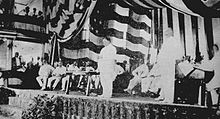Filipino Assembly
The Philippine Assembly is the first freely elected lower house in the Philippines , the first elections addressed by the Philippines Commission after the end of the Philippine-American War for a civil bicameral legislature to be constituted . The Philippines Commission formed the upper house in this system. A total of 80 parliamentary seats were allocated for the Philippine Assembly.
prehistory
During the Philippine-American War , the Schurman Commission worked out recommendations to transfer the new colony from the military administration of the archipelago to a civil colonial administration as quickly as possible, including the formation of a bicameral legislature. The Taft Commission should implement these proposals from 1900 onwards. After the dissolution of the independent First Philippine Republic in 1901, William Howard Taft commissioned a census survey . This survey was conducted in 1903 and published in 1905. 104,996 registered voters were listed. Eligibility for voting was required to be 23 years of age and the ability to read and write. Illiterates and women were excluded from voting.
Election of June 30, 1907
The election for the Philippine Assembly was held on June 30, 1907. A total of 98,251 people voted, which corresponds to a turnout of over 90%. A large number of parties competed for the parliamentary seats, including the Nacionalista Party , the Progresistas and the Independientes. The Nacionalista won 31 seats (plus Manuel Quezon, who ran as an independent candidate); the Independientes 20 seats; the Progresistas 16 seats; the Immediatistas won 7 seats and other smaller parties won 5 seats.
The Filipino Assembly
The introduction of the Philippine Assembly took place on October 16, 1907 in the Manila Grand Opera House . William Howard Taft, who was then US Secretary of War and who gave a speech at the opening of the Philippine Assembly , came from the United States . The Governor General of the Philippines Smith also delivered a speech and Bishop Jose Barlin offered a solemn prayer. Sergio Osmeña was elected speaker of the assembly . Since no party could achieve a majority in the house in the election, different alliances were formed to pass the legislative proposals. Some elected members of the assembly were already represented at the Malolos Congress, these were Pedro Paterno , Felipe Agoncillo , Leon Ma. Guerero , Aguedo Velarde and Alberto Barretto . Of the 80 members of the assembly, 48 were lawyers .
The first Filipino Assembly worked until the Philippine Autonomy Act 1916 went into effect. The parliament called the Philippine Legislature was created , which consisted of a Senate and a House of Representatives and whose members were only Filipinos. This system was maintained for 19 years until the Commonwealth of the Philippines was founded in 1935, the Commonwealth Congress .
Web links
- The Philippines: Past and Present (Volume 1 of 2) by Dean C. Worcester Projekt Gutenberg (English)
- The History of the First Philippine Assembly (1907-1916) National Historical Commission of the Philippines (English)
- History of the Senate of the Philippines Website of the Senate of the Philippines (English)
